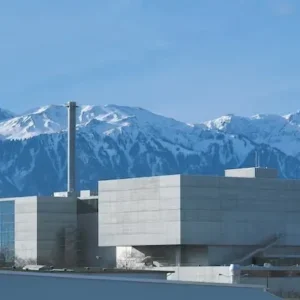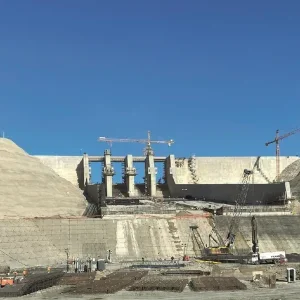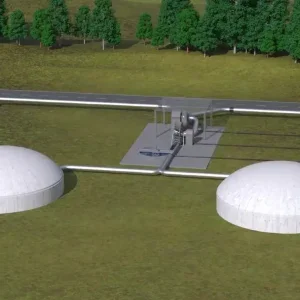The rehabilitation of existing dams and spillways continues to be the largest market for roller compacted concrete (RCC) but new structures, such as gravity dams for water supply and flood control, emergency spillways for new earthfill dams, and grade control and streambank stabilisation projects are still built quite frequently.
The primary use of RCC in the rehabilitation of dams fall into two general areas: overtopping protection and buttressing. Urbanisation in the US has created a situation where many of the dams that once presented a low risk to property and life are now being reclassified as high hazard due to development in the downstream breach zone. This change is accompanied by the requirement to safely pass a greater design storm than the dam was originally designed for.
Land use changes, topographical constraints, and restrictions on flood pool elevations and flood frequency leave the dam owner few options to find additional spillway capacity. Often the only option is to pass a portion of the inflow over a portion of the dam, or in some cases, the entire dam.
RCC has now been used at over 70 dams in the US to provide overtopping protection. These dams have ranged from 5-31m in height with RCC volumes ranging from 750-90,000m3. One of the longest overtopping spillways was constructed at Lake Tholocoo dam in Southeastern Alabama. This spillway was 464m long, placed over a 14m high embankment. A more typical size is found at Saddle dam in Indiana. This spillway is 93m long using 9100m3 of RCC. The Portland Cement Association, under contract to URS, has developed a detailed manual for RCC overtopping spillways which provides information on all the design aspects of RCC.
The second most-used application for RCC is in increasing the stability of existing concrete and masonry dams. In most cases, the stability of these dams is called into question because of a change in the seismic loading requirements. RCC is used to provide an increase in lateral support between existing buttress walls or is added to the downstream slope of the dam to increase its overall mass.
The Weber dam in California was recently rehabilitated with RCC. A triple concrete arch dam built in 1923, its main centre arch is 38m wide and 28m tall. The buttress arms of the main arch were founded on fractured weak rock and did not provide enough lateral support during the design earthquake event. RCC ( 8030m3) was placed at the base of the arch and around both sides of the two buttress arms.
The Logan First dam in Utah comprises two vertically faced buttress dam segments with a central Ambursen spillway segment. It was built in 1914, and is now under reconstruction to improve stability during an earthquake event. RCC will form blocks 9.3m high and 6.2-9.3m long to buttress the downstream face of the dam. It is calculated that the active fault adjacent to the dam could rupture, resulting in a 1.9m downward displacement. The rehabilitation is designed so that the blocks, while displaced during an earthquake, will prevent a sudden release of the reservoir waters.
Rehabilitation projects in Canada
In British Columbia, Canada, two rehabilitation projects incorporating RCC were recently completed. At the Skins Lake dam, west of Prince George, erosion had occurred at the outlet of the service spillway between two of ten saddle dams. The flow exiting the spillway was creating a large eroded plunge pool that would eventually work its way over to the toe of one of the saddle dams. RCC was used to construct a hardened stilling basin to prevent any future erosion.
The Cleveland dam in North Vancouver has had a problem with seepage through the left abutment ever since the reservoir was first impounded. Cleveland is a concrete gravity arch dam built in 1952. While the dam is founded on rock the left abutment area sits on a glacial outwash deposit that is over 145m deep. Seepage from the reservoir was removing the sands from the deposit creating a concern that piping could eventually develop. RCC was used as a component on a seepage barrier along a 600m length of the abutment. It was also placed in horizontal lifts against a 2:1 slope for a height of 12m. Beneath the RCC was a concrete bentonite cutoff wall extending to depths of 25m.
Two of the largest RCC projects in the US are moving towards full RCC production or final design. The Olivenhain dam in San Diego will be a 97m high gravity dam using 1M m3 of RCC (see p33 for more details). The Saluda dam in Columbia, South Carolina, will have a backup dam constructed immediately downstream of the existing 64m high by 1850m long puddle core earth dam built in the 1920s. A 650m long section of the backup dam will be RCC. The remainder of the new dam will be rockfill.
During the design phase of these two new gravity dams, multi-million dollar RCC mix design programmes were completed. In each case full-scale aggregate production programmes were conducted on-site along with several RCC test sections. The test sections were used to evaluate lift thickness, RCC mix designs varying cement and pozzolins quantities, different types of bedding mixes between lifts, and different lift joint maturities on lift joint properties. The results of the test programmes are still being evaluated but when completed will provide useful information on the effect of lift joint properties and treatments affecting tensile strength and shear strengths. The main governing design criteria for the Olivenhain dam is the tensile strength of the horizontal lift joints and at the Saluda dam it is the residual shear strength of a cracked lift joint.
With the recent interest in the potential of expanding the uses of RCC in the reconstruction of locks and their ancillary structures, the US Army Corps of Engineers (USACE) in association with PCA, the Bureau of Reclamation, the Natural Resources Conservation Service, and several consulting firms, created a RCC research committee. The committee’s task is to develop a programme of research needs and, when funding becomes available, develop and implement the research. The committee’s first task is to determine the best way, if possible, to produce air-entrained grout-enriched RCC. Extensive laboratory and some fieldwork has so far produced limited success. Follow-up work is planned in 2002.
Additional research is planned in 2002 to determine the freeze-thaw resistance of RCC and ways to increase its resistance to freeze-thaw in saturated conditions. The committee has teamed up with hydro-quebec, which has started its own research into RCC use in future hydro projects. USACE and Hydro Quebec are now working together to prioritise research needs, split the workload, and share results to extend the funding through efficiency.
Related Articles
Spotlight on…RCC






